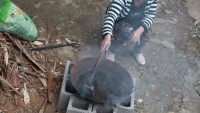Tibetan Plateau Warming Twice as Fast as Rest of World
| Michael A. Katz | | Jan 07, 2015 01:19 PM EST |
Temperatures have been rising on the Tibetan Plateau twice as fast as most places on Earth over the past 50 years, according to a recently published report coming out of China.
In its report, the Institute of Tibetan Plateau Research at the Chinese Academy of Sciences predicts the glaciers in the region will shrink by as much as another 30 percent over the next 35 years.
Like Us on Facebook
"We have studied dozens of glaciers on the Tibetan plateau in the past decades, and found that they have been shrinking, especially in the most recent decade," Yao Tandong, director of Institute told China state news agency Xinhua. "The rate of retreat has been accelerating."
The glaciers and ice fields on the Tibetan Plateau represent one of the largest ice masses in the world, and the area is often referred to as Earth's "Third Pole." In May, a report said the glaciers had already shrunk around 8,000 square kilometers over the past 30 years.
Many Himalayan shepherds have welcomed the increased temperatures from climate change because it means they don't have travel as far to bring their flocks to grazing pastures, and fewer livestock die over the winter. However, the retreat of the glaciers could mean serious trouble for surrounding areas
The shrinking of the glaciers could disrupt water supply to several major rivers in Asia that originate from the plateau, including the Yellow river and Yangtze river in China, as well as the Brahmaputra in India.
However, the news coming out of the Institute of Tibetan Plateau Research report wasn't all bad. It said that the human response to try to counter the effects of climate change has been promising.
"The local government and central government have paid close attention to environmental protection in the Tibetan region. This shows that humans are actively responding to climate change," said Yao.
"Also, we simulated the ecosystem in the region for the next 100 years based on what we know about past patterns and current natural and human activities. It also shows a positive curve."
TagsTibetan Plateau Warming Twice as Fast as Rest of World, Institute of Tibetan Plateau Research at the Chinese Academy of Sciences, glacier retreat, glaciers, global warming, Yao Tandong, Tibet's glaciers at their warmest
©2015 Chinatopix All rights reserved. Do not reproduce without permission
EDITOR'S PICKS
-

Did the Trump administration just announce plans for a trade war with ‘hostile’ China and Russia?
-

US Senate passes Taiwan travel bill slammed by China
-

As Yan Sihong’s family grieves, here are other Chinese students who went missing abroad. Some have never been found
-

Beijing blasts Western critics who ‘smear China’ with the term sharp power
-

China Envoy Seeks to Defuse Tensions With U.S. as a Trade War Brews
-

Singapore's Deputy PM Provides Bitcoin Vote of Confidence Amid China's Blanket Bans
-

China warns investors over risks in overseas virtual currency trading
-

Chinese government most trustworthy: survey
-

Kashima Antlers On Course For Back-To-Back Titles
MOST POPULAR
LATEST NEWS
Zhou Yongkang: China's Former Security Chief Sentenced to Life in Prison

China's former Chief of the Ministry of Public Security, Zhou Yongkang, has been given a life sentence after he was found guilty of abusing his office, bribery and deliberately ... Full Article
TRENDING STORY

China Pork Prices Expected to Stabilize As The Supplies Recover

Elephone P9000 Smartphone is now on Sale on Amazon India

There's a Big Chance Cliffhangers Won't Still Be Resolved When Grey's Anatomy Season 13 Returns

Supreme Court Ruled on Samsung vs Apple Dispute for Patent Infringement

Microsoft Surface Pro 5 Rumors and Release Date: What is the Latest?












